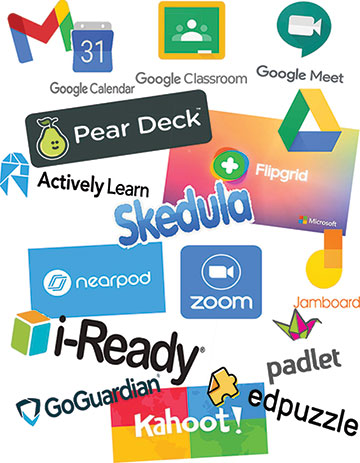
Showdown on West Coast Docks: The Battle of Longview
(November 2011).
click on photo for article

Chicago Plant Occupation Electrifies Labor
(December 2008).
click on photo for article

May Day Strike Against the War Shuts Down
U.S. West Coast Ports
(May 2008)
click on photo for article

February 2021
Google + D.O.E. + de Blasio
& Cuomo = Capitalist CHAOS
By Class Struggle Education Workers/UFT
It is difficult to convey the extent of the disarray that has engulfed NYC public schools, with constantly changing protocols (like the back-and-forth over whether parental consent for COVID-19 testing is required for students to enter the schools); shifting plans on remote classes (how much to be “synchronous” rather than “asynchronous,” where there is no teacher present at all, even on-screen); schools opening and closing, often on a day’s notice; plans for 100,000 daycare slots for working parents reduced to 28,000, and no after-school care, etc. Parents can’t make work plans, mothers in particular have lost their jobs in order to stay home with children. Facing all this, parents’ justified distrust of Mayor de Blasio, Schools Chancellor Carranza and the Department of Education (D.O.E.) – as well as the limited hours of in-person classes and the need for stability – is one of the main reasons why the number of students opting for fully remote instruction shot up from one-quarter in early August to three-quarters by November.
Reopening schools for in-person instruction for all NYC public school students with drastically reduced class sizes, vastly improved ventilation and sanitation, and systematic testing would have been perfectly possible, with careful planning and billions of dollars. They had months to prepare. Instead, they tried to run three different systems (in-person, “hybrid” and remote) simultaneously. The predictable result: none of them worked. They couldn’t have, even if COVID infections hadn’t spiked in a second wave. We have chronicled some of the ensuing chaos in several posts on the CSEW website under the rubric “Diary of a Mad Teacher (Adventures in D.O.E. Land).” From a teacher in a Brooklyn high school:
“There was complete organizational mayhem in the school when I arrived. Schools were set to open on September 21, but teachers had no programs until the tail end of the prior week. There was a slew of PDs (professional development sessions) and it was apparent that many teachers had significant difficulty with technology. The D.O.E., apparently, wants to more closely monitor communication between teachers and students, so all students had to access new nycstudents.gov emails….
“And the tech issues! Students who received devices from the school in the Spring no longer had Internet on them, and were extremely confused about the process to get it back. This is especially true for many immigrant parents and students who could use in-person assistance with the devices, but the school is not accepting in-person technology assistance meetings at the time….
“There’s no real learning happening. The students know it. The teachers know it. But it looks nice on paper (nice Google slides, nice lesson plan, etc.). The students have complained incessantly that they are not learning and they are right.”
Both for remote and “blended” classes, the bewildering array of platforms, and problems logging on and switching from one to another, are a labyrinth. Here’s from another posting on the CSEW site, “‘Zoom School’ Is Not Education: Welcome to Google Hell”:
“After the on-off-on again experience with Zoom in the spring, Google Classroom is now the standard, and can be difficult to navigate. First, there’s the Stream for posting daily announcements, and where students have access to the Google Meet link (which needs to be activated and made visible by the teacher to students under the settings). However, if students are using iPads, which many are, the Google Meet links on the banners are not visible and difficult to find…. So, teachers must also consider how Google Classroom appears and functions on multiple devices (laptops, iPhones, androids, iPads).”
Under the Classwork tab, new assignments, rubrics and documents are to be added (like Google Slides, Google Docs, Powerpoint). And teachers have to keep up on any changes in their roster, on IO Classroom (formerly Skedula).
“On top of all this, administrators are added to Google Classroom as ‘teachers,’ where they can keep tabs on teacher materials and assignments and join Google Meet and Zoom calls at will. And since Google Meet does not allow teachers to view both the chat/participants and their shared screen at the same time (like Zoom does), administrator presence may go unnoticed.”
So much for union rules limiting administrators’ observations!
 (Internationalist illustration)
(Internationalist illustration)Trying to get students engaged involves using tools such as Peardeck (a Google Slides extension), Nearpod, Kahoot, Book Creator, Adobe Spark, Flipgrid, Actively Learn, iReady, Padlet, EdPuzzle, Jamboard, the list goes on. But the learning curve is steep, and it can take 15 minutes just to get students logged in. Moreover, “The demand for student engagement is so high, some schools have opted for GoGuardian, a software tool downloaded onto school devices (popularly Google Chromebooks) that allows teachers and administrators to view student screens and search history…. [T]his presents a serious privacy issue for families given that administrators and teachers can track student browser history, even outside school hours…. Administrators can even use GoGuardian to monitor teachers without their ever knowing. No need to join the Google Meet or Zoom call as a participant, just log onto GoGuardian spyware.”
Meanwhile, “Students are feeling the full weight of remote learning. At many schools, students have up to seven classes in a row … if they could even manage to log on to all of them. Lack of access to stable internet connection and devices (many students are using their phones to attend synchronous classes and submit work, or are sharing devices with siblings), navigating new student email account registration, re-booting iPads and other devices from the previous year that lost internet connection over the summer, joining multiple Google Classrooms with various links and codes, and dealing with endless changes in schedules, plus working out tough decisions with their families to go blended or fully remote… students have it rough.” And then there’s grading, a.k.a. “The Joys of Skedula”:
“Teachers generally grade all posted assignments using the Google Classroom gradebook, as it’s most convenient for students because that’s where all work is centralized. But if there is no feature to import grades from Google Classroom to Skedula/IO Classroom, the semi-official gradebook, teachers would need to manually re-insert grades. For middle and high school teachers, we’re talking about grades for about 125-170 students, in two gradebooks. Now, there are three general categories which go toward report card grades: formative assessments, summative assessments, and participation. Students might get ten or so grades for formative assessments on homework and classwork; summative assessments, perhaps two times per marking period; and participation grades, depending on how the school calculates them (daily, weekly, bi-weekly), could run into double digits. So do the math: in a typical marking period, unless they have a program like Jupiter to automatically sync Google Classroom grades, teachers could be manually inputting several thousand grades.”
Did your eyes glaze over? That’s what teachers and students are facing in this helter-skelter “system.” Whether fully remote or hybrid/blended, it’s a torture chamber for all concerned.
Underlying the chaos is the fact that the NYC school reopening was designed by people who are clueless about the actual process of education. Since Republican mayor Michael Bloomberg, New York City schools have been a playground for consultants, Big Data freaks and corporate education “reformers” who want to run public education as a business (and siphon off juicy profits). After pushing through a law for mayoral control of the schools in 2002,1 with the connivance of the UFT tops led by Randi Weingarten, Bloomberg’s watchword was “no vendor left behind.” Under Democrat de Blasio, the same practices continue. Thus, last spring the city issued a $1.2 million contract, described in a D.O.E. statement2 as “project management support for crisis response priorities and mapping out the planning for resuming school in school buildings,” awarded to Accenture LLP, along with its $1.7 million annual consultancy contract.
So if you’re wondering how such a screwed-up plan could ever have been devised, start with the fact that it was “mapped out” by the world’s largest business management consulting firm, with 500,000 employees globally. Accenture boasts that it has “decades of experience in higher education,” but judging from its education blog, none in K-12 education, which is an entirely different world. A second factor would be the management style of de Blasio, who notoriously waits til the last minute to make decisions and “sees himself as a policy wonk who is not into the ‘nitty-gritty of being a manager’,” according to a Democratic political consultant.3 A third factor is the constant feuding between the mayor and governor. But they are just capitalist politicians, what are they supposed to know about education? The reality is that, while there may have been complaints, no one in the D.O.E. upper echelons insisted that this messed-up system can’t work.
This is the result of mayoral control of the schools. As Leonie Haimson of the advocacy group Class Size Matters stated in prepared testimony to the NY State Assembly, “Under Mayor Bloomberg, the ARIS school data system cost more than $100 million, was rarely used, and was eliminated in 2014. The special education data system called SESIS cost more than $130 million and is so dysfunctional it is now being replaced by another system.” Under Democratic mayor Bill de Blasio, the expenditure for the D.O.E. bureaucracy in the central and borough offices has ballooned from $489 million in 2014 to a projected $734 billion in 2020. He created a new layer of nine “executive superintendents” to oversee the 31 district superintendents. Altogether, the NYC Department of Education has 1,189 educrats making from $125,000 to $262,000 a year.4 But the top levels are mainly managers with little experience in education.
Under the old Board of Education, the upper levels of the school bureaucracy were mainly filled by former teachers who climbed up the ladder to executive positions. Under Bloomberg, a whole new layer of administrators was put in place, many with scant teaching experience. Their main qualification was graduating from either the Broad Superintendent’s Academy of the Broad Center for the Management of School Systems, or from the Aspiring Principals Program of the NYC Leadership Academy, once headed by former GE chairman Jack Walsh. The first was the creation of multibillionaire charter school promoter Eli Broad, and boasted in 2009 that 43% of all large urban superintendent positions were filled by its graduates, while the second was multibillionaire Bloomberg’s creature, supplying 466 principals of NYC schools over 14 years. Accompanying the privatizing charterization, this was the corporatization of public education.
The result was the chaos that characterized the New York City schools all last fall. After de Blasio closed all schools in November in anticipation of a Thanksgiving spike in COVID infections, a group of parents of “blended” students formed a group calling itself “Keep the Schools Open NYC.” It quickly gathered 15,000 signatures to open schools, pointing to the low virus transmission rate in school, and the inferiority and harmfulness of “remote education” for their children, as well as the difficulty that closing schools posed for working parents, especially women. But while the group emphasized it was pro-science, a number of those speaking for it adopted an anti-labor position, blaming teachers unions for keeping schools closed. Saying he heard the parents “loud and clear,” in early December the mayor reopened elementary schools for five-day-a-week instruction.
The colossal mismanagement of New York City schools last fall was not the result of teacher union resistance to reopening. After demanding that certain safety protocols and testing provisions be met, the United Federation of Teachers approved the reopening. Rather, the chaos in the schools this fall matched the disastrous handling of the COVID-19 pandemic in the spring,5 and more recently the turbulent rollout of vaccinations. In each case, you had squabbling bourgeois politicians and incompetent “managers” running a system serving the interests of capital rather than the needs of the population.
Now that Trump is out and Democrat Biden is calling to open the schools, suddenly the liberal media which earlier chronicled the endless twisting and turning of the stop-and-go NYC school reopening, now deems it a success story: “Despite Bumps, New York’s Move to Open Schools Pays Dividends,” New York Times, 14 February.
Public schools provided with adequate resources rather than starved for funds, run by union-led councils of teachers, students, parents and workers rather than under the control of an erratic mayor and arrogant educrats, could have provided in-person education for all 1.1 million New York City public school students. But that would require a class-struggle leadership of labor and a workers party fighting on a transitional program pointing the way to a planned economy under a workers government. What we got instead was the chaos of capitalism. ■
See also Chaotic
Reopening of NYC Schools: This Is What Mayoral
Control Looks Like (February 2021)
- 1. Traditionally in the United States, since the 19th century public schools have been governed by school boards, mostly elected in municipalities or counties. However, in New York City, from the very beginning in 1902, a Board of Education was appointed by the mayor. After the battle over community control in the late 1960s, 33 school districts were formed with elected boards, while the Board of Education was appointed by the mayor and borough presidents. Amid complaints over the notoriously dysfunctional BOE and allegations of corruption against district boards, in 2002, Bloomberg pushed through a state law giving the mayor exclusive control over the schools through the Department of Education. See “No to Mayoral Dictatorship Over the Schools!” (February 2009) and “Enough of Billionaire Mayor’s Control” (November 2010) at the CSEW web site,http://edworkersunite.blogspot.com .
- 2. New York Post, 18 April 2020. That’s on top of a $1.66 million annual contact for “management consulting.”
- 3. “How N.Y.C.’s Mayor Ignored Warnings and Mishandled Reopening Schools,” New York Times, 19 September 2020.
- 4. New York Post, 16 May 2020.
- 5.See “A Tale of Two Cities: Wuhan – New York,” in The Internationalis No. 59, March-April 2020.